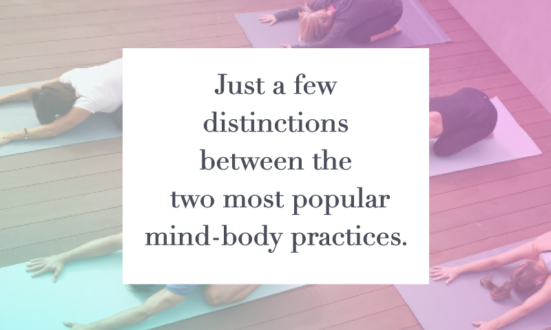While Pilates and yoga are both considered mind-body practices – and there are numerous similarities – there are distinct differences between the two disciplines. We thought we’d take a moment to explore those differences so you can determine what’s best for you – be it one, the other, or a combination of the two (which is trending in popularity, by the way).
There are many types of yoga as well as many schools of Pilates. Comparing them can be tricky, so let’s focus on what classical Pilates, such as Peak Pilates® teaches, and Vinyasa or ‘Flow’ yoga.
First, let’s look at the similarities in the instruction. Teachers of both disciplines traditionally become certified only after completing extensive training programs to develop expertise in guiding students in the intricacies of correct posture, form, technique and modifications.
When it comes to the exercises, both Pilates and yoga are low-impact and help to bring your body into better harmony by balancing muscle groups and working your core – all the while focusing on a dedicated breathing rhythm. However, the techniques to achieving this bodily balance are vastly different between yoga and Pilates. The overarching philosophy of each practice is distinct as well.
YOGA
Yoga is considered a mind-body-spirit practice because the overarching intention is to unite the mind, body, and spirit. Indeed “yoga” actually means “union.”
In physicality, yoga combines breathing techniques (pranayama) with physical poses (asanas), whereby you use your body weight as resistance. During a class, you adopt a position and either hold it for a period of time or flow into another position (vinyasa) by following your breath for focus. By concentrating on the breath, you can then drop into greater “inner stillness” or a meditative state. Many people also report a greater connection to their Spirituality – in whatever form that may be – through their yoga practice.
While yogic union of mind, body and spirit is the ultimate goal – no matter how many weeks, months, or years it may take – yoga has myriad physical benefits along the way. Yogis report less back, neck and knee pain; less stress and/or stress-related illness; better balance; weight loss assistance; enhanced sleep; and greater ease of menopause symptoms.
PILATES
Pilates is a mind-body practice that requires you to stabilize the powerhouse (core) while performing a sequence of repetitive range-of-motion exercises. More specifically, whether you are on a mat or utilizing Pilates equipment like a Chair or Reformer, the goal is to challenge your powerhouse while moving your limbs freely, ideally creating ease and efficiency of movement. Like yoga, the physicality of Pilates increases strength and flexibility while also developing stability and stamina.
While breathing is also essential to Pilates, there is less of an emphasis on the breath as a means to reach greater spiritual attainment and instead the breath is used to help stabilize and guide movement. Peak Pilates® teaches the six essential principles that guide the mind-body practice:
- Concentration: “The mind controls the body.”
- Centering: Stabilize and guide movements from your powerhouse.
- Control: Keep your body under control and control the springs, so that you work with muscle not momentum.
- Precision: Heal and prevent injury through aligning and balancing the body.
- Breathing: Let the breath flow with the movement. A full exhale, encourages a full inhale.
- Flowing: Let one movement flow into next.
Pilates helps to develop a healthy mind in a healthy body. Pilates has been proven to improve back, hip and knee pain; as well as improve stability, flexibility and posture. Like yoga, Pilates can help you de-stress and deal with anxiety.
Now that you know the broader philosophies and key variables of Pilates and yoga, you can assess which is right for you based on your individual desires and needs. However, you don’t need to choose between the two. Think of the fun you could have crafting a weekly workout routine that incorporates them both!



